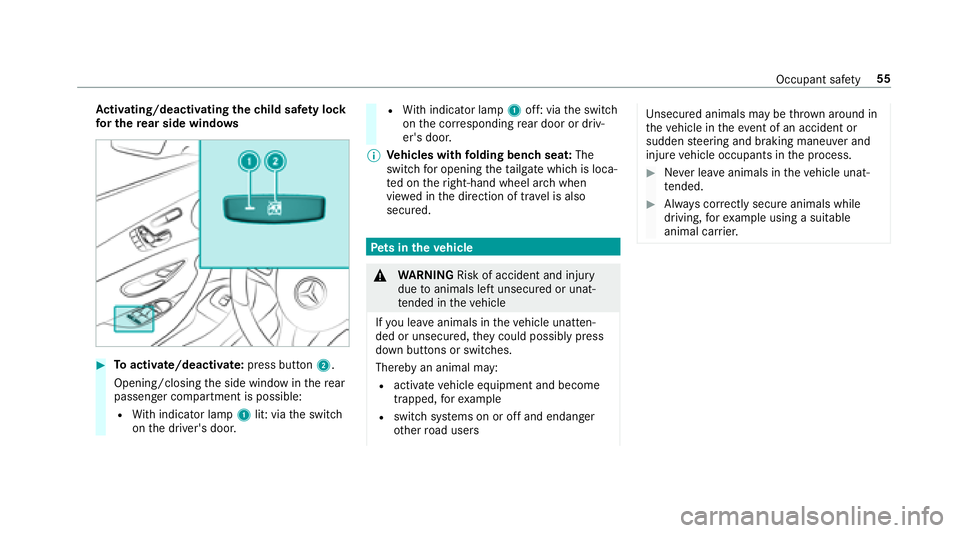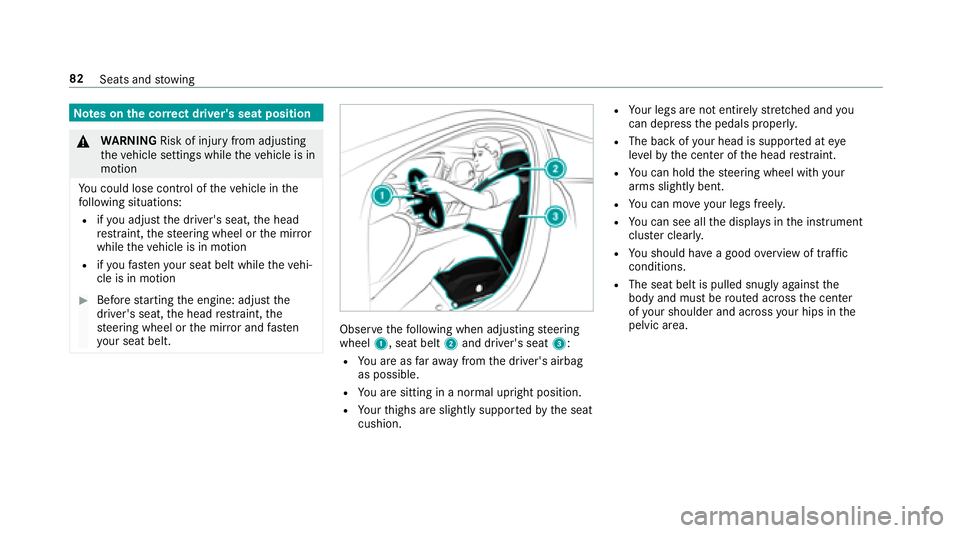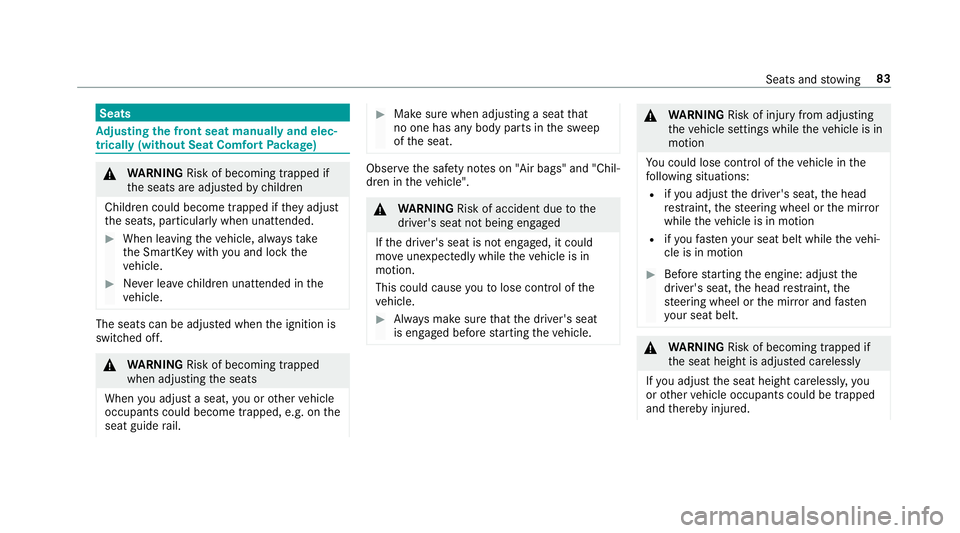2018 MERCEDES-BENZ E-CLASS WAGON steering wheel
[x] Cancel search: steering wheelPage 5 of 506

Drivingand pa rking ................................. 143
Driving ........................................................ 143
DY NA MIC SELECT switch ........................... 150
Au tomatic transmission .............................. 151
Re fueling .................................................... 155
Pa rking ...................................................... .157
Driving and driving safe ty systems ............ .166
Instrument Display and on-board
comp uter ................................................... 215
Instrument display overview ...................... .215
Overview of the buttons on thesteering
wheel ......................................................... .216
Operating the on-board computer ............... 216
Displ ays in the multifunction display ........... 218
Ad justing the instrument lighting ............... .218
Menus and submenus ................................. 219
Head-up Display ......................................... 225
Vo ice Control Sy stem .............................. 227
Operating saf ety........................................ .227
Operation ................................................... 227
Using Voice Cont rol Sy stem ef fectively ...... 229
Essential voice commands ........................ .229
Multimedia sy stem .................................. 239
Overview and operation .............................. 239
Sy stem settings .......................................... 247
Na vigation .................................................. 258
Te lephone .................................................. .281
Online and Internet functions ..................... 297
Media ......................................................... 304
Ra dio .......................................................... .316
Sound ......................................................... 323
Main tenance and care ............................. 326
ASS YST PLUS service inter val display ........ 326
Engine compartment .................................. 327
Cleaning and care ...................................... .333
Breakdown assist ance............................ 340
Emergency .................................................. 340
Flat tire ....................................................... 340
Battery (vehicle) ......................................... 346
To w starting or towing away ........................ 351
Electrical fuses ........................................... 356
Wheels and tires ...................................... 360
Noise or unusual handling characteris‐
tics ............................................................ .360
Che cking wheels and tires regularly ........... 360
No tes on snow chains ................................ .361
Ti re pressure .............................................. .361
Loading theve hicle .....................................3 67
Ti re labeling ................................................ 372
Definition of term sfo r tires and loading ..... 377
Changing a wheel ...................................... .380
Tech nical data .......................................... 390
No tes on tech nical da ta.............................. 390
Ve hicle electronics .....................................3 90
Ve hicle identification plate, VIN and
engine number ...........................................3 92
Operating fluids .......................................... 394
Ve hicle data ................................................ 400
Display messages and warning/indi‐
cator lamps .............................................. 402
Display messages ...................................... .402
Wa rning and indicator lamps ...................... 449
Conte nts 3
Page 9 of 506

1Steering wheel gearshift paddle →
153
2 Combination switch →
124
3 DIRECT SELECT le ver
4 Displ ay(multimedia sy stem) →
239
5 Start/ Stop button →
144
6 Control panel forth e multimedia sy stem →
239
7 Climate control sy stems →
137
8 Glovebox →
103
9 Hazard warning lamps →
125
A Stow age compartment →
103
B Control elements forth e multimedia sy stem →
239
C Lowe rsthere ar seat head restra ints →
89
D ECO start/ stop function →
149
E Active Parking Assist →
201
F Sets theve hicle le vel →
189G
DYNA MIC SELECT switch →
151
H PASSENGER AIRB AGindicator lamp →
, 42
I Cont rol panel forth e multimedia sy stem →
216
J Adjusts thesteering wheel →
98
K Control panel forth e on-board computer →
216
L Cruise cont rol le ver →
175
M Unloc ksthe hood →
327
N Elect ric park ing brake →
163
O Light switch →
123
P Control panel for:
Ac tive Steering Assist →
184
Ac tive Lane Keeping Assist →
212
Pa rking Assist PARKTRONI C →
192
Head-up Display
At aglance – Cockpit 7
Page 29 of 506

eral acceleration, display ofthefast ened seat
belts)
Rmalfunctions or defects in impor tant sy stem
components (e.g. lights, brakes)
Rinformation on vehicle damage events
Rsystem reactions in special driving situations
(e.g. air bag deployment, inter vention of sta‐
bility control sy stems)
Rambient conditions (e.g. temp erature, rain
sensor)
In addition toprov iding the actual control unit
function, this data assists the manufacturer in
de tecting and rectifying malfunctions and opti‐
mizing vehicle functions. The majority of this
data is temp orary and is only processed in the
ve hicle itself. Only a small portion of the data is
st ored in theeve nt or malfunction memor y.
When your vehicle is serviced, tech nical da ta
from theve hicle can be read out byservice net‐
wo rkemplo yees or third parties. Services
include repair services, maintenance processes,
wa rranty events and quality assurance meas‐
ures, forex ample. The read out is per form ed via
th e legally prescribed port for OBD ("on-board diagnostics") in
theve hicle. The respective
service network locations or third parties col‐
lect, process and use the data. They document
te ch nical statuses of theve hicle, assist in find‐
ing malfunctions and impr oving quality and are
transmitted tothe manufacturer, if necessar y.
Fu rther more,
the manufact
urer is subjectto
product liability. Forth is, the manufacturer
requ irestech nical da tafrom vehicles.
Malfunction memories in theve hicle can be
re set bya service outlet as part of repair or
maintenance work.
They can enter data into theve hicle's con veni‐
ence and inf otainment functions themselves as
part of the selected equipment.
This includes, forex ample:
Rmultimedia data such as music, films or pho‐
to sfo r playba ckin an integrated multimedia
sy stem
Raddress book data for use in connection with
an integrated hands-free sy stem or an inte‐
grated navigation sy stem
Rentered navigation destinations
Rdata about the use of Internet services This data can be
stored locally in theve hicle or
is located on a device which you ha veconnected
to theve hicle. If this data is stored in theve hi‐
cle, you can dele teit at any time. This data can
only be transmitte dto third parties upon your
re qu est with particular rega rd tothe scope of
use of online services according to your selected
settings.
Yo u can store or change con venience settings/
individualization in theve hicle at any time.
Depending on the equipment, this includes, for
ex ample:
Rseat and steering wheel position settings
Rsuspension and climate control settings
Rindividualization such as interior lighting
If yo ur vehicle is accordingly equipped, you can
connect your smartphone or ano ther mobile end
device totheve hicle. You can cont rolth em via
th e control elements integrated in your vehicle.
Images and audio from the smartphone can be
output via the multimedia sy stem. Cer tain infor‐
mation is simultaneously transmitte dto yo ur
smartphone.
General no tes 27
Page 41 of 506

&WARNING Risk of injury or death dueto
incor rect seat position
If yo ude viate from the cor rect seat position,
th e air bag cannot perform its intended pro‐
te ctive function and deployment may even
cause fur ther injuries.
To avo id hazardous situations, alw ays make
sure that all vehicle occupants:
RHa ve their seat belt fastened cor rectly,
including pregnant women.
RAre seated properly and that dis tance to
th e air bags is as large as possible.
RObser vethefo llowing information.
#Alw ays make sure that there are no
objects between the air bag and the
ve hicle occupant.
To avo idrisks resulting from the deployment of
th e air bag:
RBefore starting your journe y,adjust your seat
co rrectly ;th e driver's seat and front
passenger seat should be mo ved as far back
as possible. When doing so, alw
ays obser vethe informa‐
tion on the cor rect driver's seat position
(
→page 82).
ROnly hold thesteering wheel bythesteering
wheel rim. This all owsth e air bag tobe fully
deplo yed.
RAlw ays lean against the seat backrest when
th eve hicle is in motion. Do not lean forw ards
or against the door or side windo w.You may
ot herwise be in the deployment area of the
air bags.
RAlw ayske ep your feet on thefloor. Do not
put your feet on the dashboard, forex ample.
Yo ur feet may otherwise be in the deploy‐
ment area of the air bag.
RIfch ildren are tra veling in theve hicle,
obser vethe additional no tes (→page 46).
RAlw aysstow and secure objects cor rectly. Objects in
theve hicle interior may pr event an air
bag from functioning cor rectly. There fore alw ays
ensure that:
RThere are no people, animals or objects
between theve hicle occupants and an air
bag.
RThere are no objects between the seat, door
and door pillar (B-pillar).
RThere are no hard objects, e.g. coat hangers,
hanging on the grab handles or coat hooks.
RThere are no accessory parts, such as cup
holders, attached totheve hicle within the
deployment area of an air bag, e.g. on doors,
side windo wsor side paneling.
RThere are no heavy, sharp-edged or fragile
objects in the poc kets of your clo thing. Store
such objects in a suitable place.
Occupant saf ety 39
Page 57 of 506

Activating/deactivating the child saf ety lock
fo r the rear side windo ws
#Toactivate/deacti vate:press button 2.
Opening/closing the side window in there ar
passenger compartment is possible:
RWi th indicator lamp 1lit: via the switch
on the driver's door.
RWi th indicator lamp 1off: via the switch
on the cor responding rear door or driv‐
er's door.
% Vehicles with folding bench seat: The
switch for opening theta ilgate which is loca‐
te d on theright-hand wheel ar chwhen
vie we d in the direction of tr avel is also
secured.
Pe ts in the vehicle
&
WARNING Risk of accident and injury
due toanimals left unsecured or unat‐
te nded in theve hicle
If yo u lea veanimals in theve hicle unatten‐
ded or unsecured, they could possib lypress
down buttons or switches.
Thereby an animal may:
Ractivate vehicle equipment and become
trapped, forex ample
Rswitch systems on or off and endanger
ot her road users
Uns ecured animals may be throw n around in
th eve hicle in theeve nt of an accident or
sudden steering and braking maneuver and
injure vehicle occupants in the process.
#Ne ver lea veanimals in theve hicle unat‐
te nded.
#Alw ays cor rectly secure animals while
driving, forex ample using a suitable
animal car rier.
Occupant saf ety 55
Page 84 of 506

Notes onthe cor rect driver's seat position
&
WARNING Risk of injury from adjusting
th eve hicle settings while theve hicle is in
motion
Yo u could lose cont rol of theve hicle in the
fo llowing situations:
Rifyo u adjust the driver's seat, the head
re stra int, thesteering wheel or the mir ror
while theve hicle is in motion
Rifyo ufa sten your seat belt while theve hi‐
cle is in motion
#Before starting the engine: adjust the
driver's seat, the head restra int, the
st eering wheel or the mir ror and fasten
yo ur seat belt.
Obser vethefo llowing when adjusting steering
wheel 1, seat belt 2and driver's seat 3:
RYou are as faraw ay from the driver's airbag
as possible.
RYo u are sitting in a no rmal upright position.
RYour thighs are slightly suppor tedby the seat
cushion.
RYo ur legs are not entirely stre tched and you
can dep ress the pedals proper ly.
RThe back of your head is support ed ateye
le ve lby the center of the head restra int.
RYo u can hold thesteering wheel with your
arms slightly bent.
RYo u can mo veyour legs freel y.
RYou can see all the displa ysinthe instrument
clus ter clearl y.
RYou should ha vea good overview of traf fic
conditions.
RThe seat belt is pulled snug lyagainst the
body and must be routed across the center
of your shoulder and across your hips in the
pelvic area.
82 Seats and stowing
Page 85 of 506

Seats
Adjusting the front seat manually and elec‐
trically (without Seat Comfort Package)
&
WARNING Risk of becoming trapped if
th e seats are adjus tedby children
Children could become trapped if they adjust
th e seats, particularly when unattended.
#When leaving theve hicle, alw aysta ke
th e SmartK eywith you and lock the
ve hicle.
#Ne ver lea vechildren unatte nded inthe
ve hicle.
The seats can be adjus ted when the ignition is
switched off.
& WARNING Risk of becoming trapped
when adjusting the seats
When you adjust a seat, you or other vehicle
occupants could become trapped, e.g. on the
seat guide rail.
#Make sure when adjusting a seat that
no one has any body parts in the sweep
of the seat.
Obser vethe saf etyno tes on "Air bags" and "Chil‐
dren in theve hicle".
&
WARNING Risk of accident due tothe
driver's seat not being engaged
If th e driver's seat is not engaged, it could
mo veunexpectedly while theve hicle is in
motion.
This could cause youto lose control of the
ve hicle.
#Alw ays make sure that the driver's seat
is engaged before starting theve hicle.
&
WARNING Risk of injury from adjusting
th eve hicle settings while theve hicle is in
motion
Yo u could lose cont rol of theve hicle in the
fo llowing situations:
Rifyo u adjust the driver's seat, the head
re stra int, thesteering wheel or the mir ror
while theve hicle is in motion
Rifyo ufa sten your seat belt while theve hi‐
cle is in motion
#Before starting the engine: adjust the
driver's seat, the head restra int, the
st eering wheel or the mir ror and fasten
yo ur seat belt.
&
WARNING Risk of becoming trapped if
th e seat height is adjus ted carelessly
If yo u adjust the seat height carelessly, you
or other vehicle occupants could be trapped
and thereby injured.
Seats and stowing 83
Page 89 of 506

#Toselect the front passenger seat: press
button 1.
When the indicator lamp lights up, the front
passenger seat is selected.
#Ad just the front passenger seat using the
buttons in the door control panel on the driv‐
er's side.
Ad justing the 4-w aylumbar support
1Toraise
2To sof ten
3To lowe r
4To harden
#Using buttons 1to4, adjust the conto ur
of the backrest individually tosuit your bac k.
Headrestra ints
Ad justing the front seat head restra ints man‐
ually
& WARNING Risk of injury from adjusting
th eve hicle settings while theve hicle is in
motion
Yo u could lose cont rol of theve hicle in the
fo llowing situations:
Rifyo u adjust the driver's seat, the head
re stra int, thesteering wheel or the mir ror
while theve hicle is in motion
Rifyo ufa sten your seat belt while theve hi‐
cle is in motion
#Before starting the engine: adjust the
driver's seat, the head restra int, the
st eering wheel or the mir ror and fasten
yo ur seat belt.
Seats and stowing 87